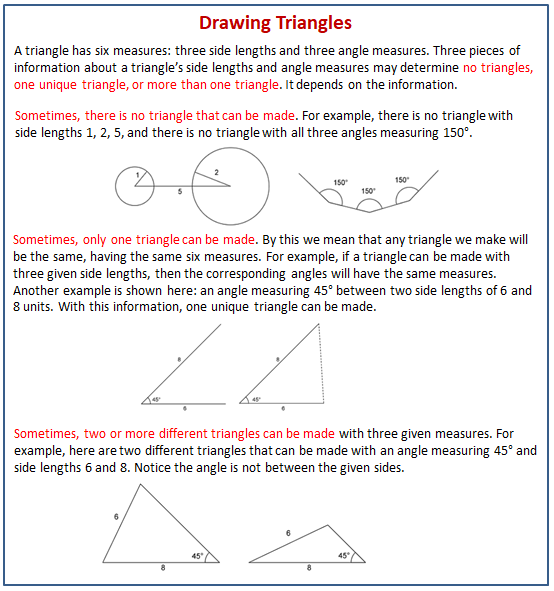Illustrative Mathematics Grade 7, Unit 7, Lesson 10: Drawing Triangles (Part 2)
Learning Targets:
- Given two side lengths and one angle measure, I can draw different triangles with these measurements or show that these measurements determine one unique triangle or no triangle.
Related Pages
Illustrative Math
Grade 7
Lesson 10: Drawing Triangles (Part 2)
Let’s draw some more triangles.
Illustrative Math Unit 7.7, Lesson 10 (printable worksheets)
Lesson 10 Summary
The following diagrams explain how three pieces of information about a triangle’s side lengths and angle measures may determine no triangles, one unique triangle, or more than one triangle.

Lesson 10.1 Using a Compass to Estimate Length
- Draw a 40° angle.
- Use a compass to make sure both sides of your angle have a length of 5 centimeters.
- If you connect the ends of the sides you drew to make a triangle, is the third side longer or shorter than 5 centimeters? How can you use a compass to explain your answer?
Lesson 10.2 Revisiting How Many Can You Draw?
Use the applet to draw triangles.
- Draw as many different triangles as you can with each of these sets of measurements:
a. One angle measures 40°, one side measures 4 cm and one side measures 5 cm.
b. Two sides measure 6 cm and one angle measures 100°. - Did either of these sets of measurements determine one unique triangle? How do you know?
Lesson 10.3 Three Angles
Use the applet to draw triangles. Sides can overlap.
- Draw as many different triangles as you can with each of these sets of measurements:
a. One angle measures 50°, one measures 60°, and one measures 70°.
b. One angle measures 50°, one measures 60°, and one measures 100°. - Did either of these sets of measurements determine one unique triangle? How do you know?
Are you ready for more?
Using only the point, segment, and compass tools provided, create an equilateral triangle. You are only successful if the triangle remains equilateral while dragging its vertices around.
Lesson 10 Practice Problems
- A triangle has sides of length 7 cm, 4 cm, and 5 cm. How many unique triangles can be drawn that fit that description? Explain or show your reasoning.
- A triangle has one side that is 5 units long and an adjacent angle that measures 25°. The two other angles in the triangle measure 90° and 65°. Complete the two diagrams to create two different triangles with these measurements.
- Is it possible to make a triangle that has angles measuring 90 degrees, 30 degrees, and 100 degrees? If so, draw an example. If not, explain your reasoning.
- Segments CD, AB, and FG intersect at point E. Angle FEC is a right angle. Identify any pairs of angles that are complementary.
- Match each equation to a step that will help solve the equation for x.
- a. If you deposit $300 in an account with a 6% interest rate, how much will be in your account after 1 year?
b. If you leave this money in the account, how much will be in your account after 2 years?
The Open Up Resources math curriculum is free to download from the Open Up Resources website and is also available from Illustrative Mathematics.
Try out our new and fun Fraction Concoction Game.
Add and subtract fractions to make exciting fraction concoctions following a recipe. There are four levels of difficulty: Easy, medium, hard and insane. Practice the basics of fraction addition and subtraction or challenge yourself with the insane level.

We welcome your feedback, comments and questions about this site or page. Please submit your feedback or enquiries via our Feedback page.